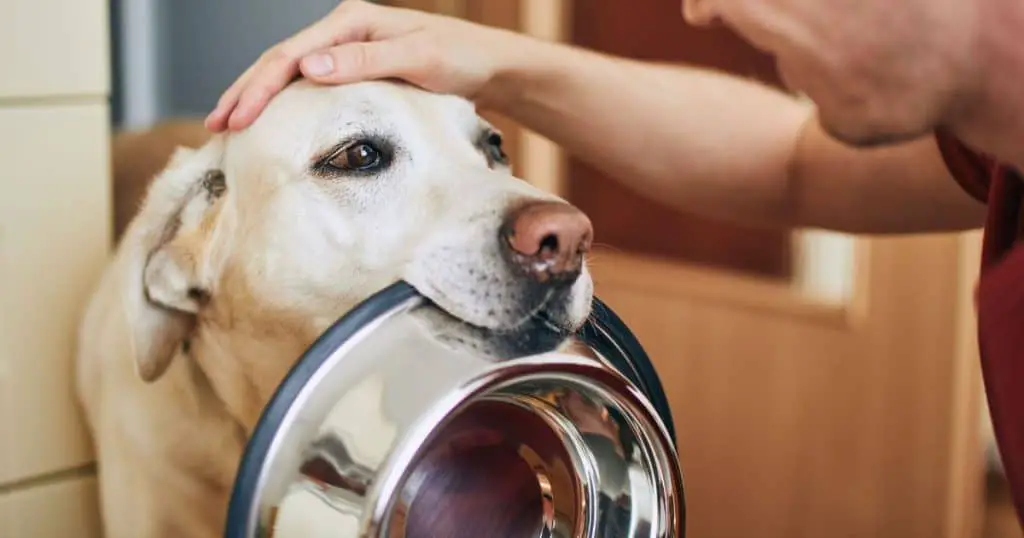What to Know
Labrador Retriever Male vs Female
Labrador retriever males and females have many differences. One of the most noticeable is the size – males are typically larger than females. Another is that males tend to be more aggressive than females, and they also have a higher intelligence level. Character and temperament can also differ, with males being more protective of their family and home while females are often more playful and loving.
Labrador Retrievers are one of the most popular breeds of dogs in the world. 🌎

They come in both male and female versions, and each has its own unique set of characteristics.
So which one is right for you? 🤔
In this article, I will compare the two sexes head-to-head and help you decide which one is best for your family and home. 🏡
I will cover everything from their intelligence level to their health issues so that you can make an informed decision before bringing a Labrador Retriever into your life.
Keep reading our article to learn more about Labrador Retriever male vs female! 🐕🦺
Ladies First so let’s Start With Female Labrador

Female Labs like other dogs tend to be sassier than their male counterparts and are generally more independent.
Labrador Retrievers can be quite energetic, and female Labs seem to have a bit more energy than males.
Female Labrador Retrievers may also be better with young kids due to their natural maternal instincts. 👶
Females Labrador will come to heat at least twice a year for 3 weeks approximately and can go into heat between seven months after the first birthday, and during this time there will be behavior changes, such as:
- Increased Restlessness
- Occasional Aggression
- More Urination
- Enlarged Breast Glands
- Thirst
And if you don’t have plans to breed them they will need to be spayed, however, if the female lab is used for breeding purposes, there are so many products on the market designed to help with the heat cycle.
When it comes to physical appearance, female Labrador Retrievers tend to be slightly smaller than their male counterparts.
Now, let’s look at Male Labrador Retrievers

One of the biggest obvious physical characteristics of the male labs is that they have a wider head and thicker neck than females.
Males also have a distinctive square-like muzzle, which is often described as having a masculine look.
Males labrador also tend to have broader shoulders, larger chests, and a heavier build.
Regarding managing male dog labs they tend to be more difficult in small areas and are prone to marking their territory with urine.
They also tend to be more dominant and determined than females and will require more discipline when it comes to training.
It’s also important to consider that male labradors are more likely to wander off, so they need a secure and safe yard with a high fence.
If they are not given enough exercise and stimulation, they can become destructive and bark excessively.
Sometimes you may find male labradors becomes possessive of the female in the household and they can even become aggressive with other male dogs.
To avoid this behavior, it’s important to socialize them early and often.
Labrador Retriever Male vs Female: Similarities

According to American Kennel Club (AKC), Labrador Retrievers are some of the most popular dogs around.
Both male and female Labradors have similar characteristics and qualities that make them excellent family pets.
They are intelligent, loyal, friendly, and easy to train. Labradors have a strong work ethic and enjoy being active and engaged in activities.
They also have an excellent sense of smell, making them suitable for search and rescue as well as detection work.
Both male and female Labradors are gentle and loving with children, although they can be protective of their territory.
Both Labrador Males and Females require the same amount of training, feeding, general care, and exercise.
In addition, for both gender vaccinations, and general veterinary checkups will be the same.
Are Female Dogs Calmer Than Males Labrador?
The Short answer is, YES. 👍
Female Labrador Retrievers tend to be more laid-back and calm than their male counterparts, but this is not always the case.
There are many factors at play when it comes to temperament, including genetic predisposition, early socialization, and training.
Female Labs usually do require less exercise than male Labs and are generally less active.
The hormones can also play a role in temperamental differences between genders.
Female dogs are generally more relaxed and passive than male dogs.
For example, labradors can divert energy into things like chewing and digging when they are stressed, but female labs may be less likely to act out in this way because of their low energy levels.
Labrador Retriever Male vs Female: Aggressive Level
Labrador Retriever males are more aggressive than females.
Males also tend to be more possessive and territorial, guarding their property against strangers or other animals.
They may also have a higher tendency to bark or growl.
Labrador Retriever Male vs Female: Health Issues
One of the most important aspects of owning a dog is health issues and when and why I need to visit a vet, to deal with the health issues of my dog.
Knowing the health issues of a Labrador Retriever is important, as it can help you decide whether you should get a male or female.
If you are considering adopting or purchasing a new puppy, there are several important factors to keep in mind:
- The lifespan of a Labrador Retriever is between ten to twelve years, which makes them one of the longest-living large breed dogs.
- Males tend to live slightly longer than females, with an average lifespan of twelve years and seven months compared to eleven years and six months.
- The most common health problem for both males and females is hip dysplasia, which can lead to joint issues and lameness.
- Both males and females may also be prone to obesity, so it is important to feed your Labrador Retriever a healthy diet and give them plenty of exercises.
- Females are more prone to pyometra, an infection of the uterus that can be life-threatening if not treated quickly.
- Both genders should be spayed or neutered, as this can help to reduce the risk of a number of health issues.
- Males are at a higher risk of prostate cancer and should be checked regularly by a vet, while females can be prone to breast cancer.
Both male and female labradors can face health issues, but there may be some differences between the two.
Here are some more important details:
The Heat Cycle
The heat cycle will start at around six months of age for female Labradors, so spaying is strongly recommended.
Actually, this is not a health issue as such, but it can be a nuisance if you’re not prepared for it.
Keep in mind that dogs in the heat cycle can be distracted and uninterested in their regular activities.
If you’re not planning to breed, the best thing would be to have your female spayed before her first heat cycle starts.
The worst thing about the heat cycle is the fact that it can attract unwanted male dogs to your area, which can be a nuisance for you and your dog.
Now when it comes to pregnancy, always keep in mind that a female in heat can get pregnant, which is why it’s so important to have her spayed before the first signs of heat.
In general, spaying can cost between $50 and $550, depending on the age of the dog.
Keep in mind that spaying is more complicated than neutering, so it usually costs more money.
On the other hand, neutering can cost between $35 and $245, depending on the vet you are using.
Neutering for Male Labradors
Neutering is recommended for male Labradors, as it reduces their risk of getting prostate cancer or developing undesirable behaviors.
Neutering can also help reduce the risk of territorial behavior, roaming, and aggression toward other animals.
However, neutering should be done before six months to prevent testicular cancer.
The cost varies depending on your vet and where you live but usually ranges from $35 to $245.
Overall, regardless of whether you choose a male or female Labrador Retriever, there are certain health issues that both may face.
Joint Issues
Labradors are prone to hip and elbow dysplasia, a condition in which the bones of the joint don’t form properly and deteriorate over time.
Both male and female Labradors may suffer from this condition, but males tend to develop it more frequently.
This can lead to joint issues and lameness, so it’s important to monitor your dog’s activity level.
If you notice any signs of discomfort, it’s best to take your dog to the vet for an examination.
Hip Dysplasia
Hip dysplasia is an inherited condition in which the hip joint doesn’t develop properly.
This painful condition can lead to lameness and difficulty moving.
Hip dysplasia is more common in large-breed dogs, and unfortunately, Labradors are no exception.
Hip dysplasia caused by genetics can be difficult to prevent, and malformed hip joints can be surgically corrected.
We earn a commission if you click this link and make a purchase at no additional cost to you.
Mild cases of hip dysplasia can be managed with exercise, weight control, and anti-inflammatory medications.
To reduce the risk of this condition in Labradors, reputable breeders should have their dogs screened for hip dysplasia to ensure that only healthy animals are bred.
Some of the mild cases can be managed using painkillers and anti-inflammatories but some cases may require surgery as the following:
Total Hip Replacement (THR)
THR is a surgical procedure used to replace the hip joint in cases of severe hip dysplasia with plastic and metal parts to restore joint function as normal.
This is a major surgery, and it should be performed only when other treatment options have been exhausted.
Crate rest can help reduce inflammation and pain associated with mild hip dysplasia.
Resting in a crate limits your dog’s activity level and prevents further damage to the hip joint.
This is the preferred option when the dog has several mobility issues and is painful.
Physical therapy can also be beneficial for dogs with hip dysplasia.
A physical therapist can help your pup build strength and improve mobility with exercises and stretches.
This should be done under the guidance of a trained professional to ensure that the dog is not being overworked or put in any further pain.
THR can cost up to $7,000 or more per hip, so it’s important to understand the risks and benefits before you decide on this procedure.
Finally, diet is also an important factor when managing hip dysplasia in Labradors.
A balanced diet with fewer calories can help reduce stress on the joints and provide essential nutrients for good joint health.
Triple/Double Pelvic Osteotomy (TPO/DPO)
TPO/DPO is a surgical procedure used to correct the malformation of the hip joints in dogs.
This surgery involves cutting and repositioning the bones in the hip socket, allowing freedom of movement and better joint function.
Usually, TPO/DPO is for younger Labs with 5-12 months of age.
The procedure can be performed with or without hip replacement surgery, depending on the severity of the joint malformation.
This surgery is generally less invasive than total hip replacement surgeries, but there is a risk of complications such as infection or nerve damage.
In general, can cost up to $3500 and more depending on the size of your pet.
The recovery time for TPO/DPO is usually between 8-12 weeks, and it’s important that you follow the instructions given by the vet after surgery.
This includes confinement, and leash walking only until muscle mass has been built back up and the joints have healed properly.
Your veterinarian will also likely advise against any kind of strenuous physical activity for at least 6-8 months.
TPO/DPO can be a great option for improving the quality of life in your pet and is worth considering if you have a Lab with a joint malformation that needs to be corrected.
With relation to our topic today Labrador Retriever Male vs Female, I can’t tell you whether this condition is more common in Labs of either gender, but there is one study suggests that:
Spayed females are more likely to develop hip dysplasia than non-spayed females, and according to another study, unspayed females are more at risk!
Therefore, there is no distinction between male and female laboratory rats when it comes to this condition.
Femoral Head Osteotomy (FHO)
FHO is a surgical procedure used to treat hip dysplasia in dogs.
It involves cutting the top part of the femur bone, which allows the acetabulum (hip socket) to deepen and hold the head of the femur more securely.
This helps reduce pain, improve joint function, and slow disease progression.
FHO is often performed when other conservative treatments for hip dysplasia, such as weight loss, physical therapy, and medication, are not sufficient to control the condition.
In most cases, FHO is performed in conjunction with a concurrent total hip replacement (THR) or triple pelvic osteotomy (TPO).
Some dogs may benefit from an arthroscopic procedure prior to FHO, which can identify and address any pre-existing conditions that might complicate or delay recovery.
The FHO will cost between $1,200 to $2,500 or more per hip, that’s including anesthesia, surgery, and post-operative care.
Recovery time after an FHO ranges from four to twelve weeks, depending on the severity of hip dysplasia and the type of procedure performed.
In relation to our article today, Labrador Retriever Male vs Female, it’s difficult to say which gender is more prone to hip dysplasia.
Elbow Dysplasia
Elbow Dysplasia is a serious condition that can cause pain and lameness in the affected joint and is similar to Hip Dysplasia.
It is most commonly seen in large breed dogs, especially German Shepherds, Labrador Retrievers, Golden Retrievers, Rottweilers, and Bullmastiffs.
The good news is that there are several steps you can take to prevent or treat Elbow Dysplasia with Labrador.
For example, you should strive to maintain your Labrador’s ideal body weight, as obesity can cause additional strain on the elbow joint and increase the risk of Elbow Dysplasia.
Regular exercise such as swimming and walking can also help prevent Elbow Dysplasia by maintaining good muscle tone and keeping joints limber.
You should also provide a nutritious diet to help keep your Labrador’s joints healthy, with omega-3 fatty acids playing an important role in this regard.
Finally, it is recommended that Labradors with Elbow Dysplasia receive regular veterinary checkups to monitor the progression of the condition.
In some cases, surgery may be necessary to repair the affected joint.
If you suspect your Labrador may be suffering from Elbow Dysplasia, then please contact a licensed veterinarian for assistance as soon as possible.
Taking these proactive steps will help ensure your beloved companion remains healthy and happy for years to come.
Regards to our topic Labrador Retriever Male vs Female, unlike hip dysplasia, there is evidence said that males are more likely to suffer from elbow dysplasia than females.
This is quite interesting and worth paying attention to.
Therefore, it’s essential for male Labradors owners to prevent this condition carefully by following the steps mentioned above in order to keep their four-legged friends healthy and safe.
Elbow dysplasia can cost a lot of money to treat, and it can range from $1,500 to $4,000 per elbow.
Obesity
Obesity is a common problem in Labradors, and it can have a number of negative consequences for your dog’s health.
Excess weight can put a strain on your dog’s joints and muscles, and it can also lead to respiratory problems and decreased stamina.
If you’re concerned that your dog is overweight, there are a few things you can do to help them slim down.
- Make sure you’re feeding them a high-quality diet that includes lean protein and plenty of healthy fruits and vegetables.
- You should also make sure they’re getting enough exercise, and you may need to cut back on their food intake if they’re eating too much.
- Talk to your vet about whether your dog might benefit from weight-loss supplements or medication.
Obesity is a serious issue, but with the right approach, you can help your Labrador reach a healthy weight.
Labrador Retriever Male vs Female, which one more in with Obesity?
There is no definitive answer as to which gender of Labrador Retriever is more prone to obesity.
Both male and female Labradors can become overweight if they are not fed correctly or given enough exercise.
Generally, neutered males tend to be at a slightly higher risk for obesity than spayed females, but it’s important to keep in mind that any dog can become overweight if their diet and exercise are not monitored.
That being said, it’s important to be aware of your Labrador’s weight and body condition score, and make sure that they maintain a healthy lifestyle.
Cancer
Labradors are known for their love of food, their friendly nature, and their affinity for water.
But did you know that they also have a higher risk of developing cancer than most other dog breeds?
In fact, labradors are the most likely breed of dog to develop cancer, with males being particularly vulnerable.
While the exact cause of this increased risk is unknown, it is thought to be connected to the labrador’s strong scavenging instinct.
When searching for food, labradors are more likely to consume things that may be contaminated with carcinogens.
This, combined with their large size and dense fur coats, makes them more susceptible to developing cancerous tumors.
What type of cancer can a labrador get?
Unfortunately, labradors are prone to many types of cancer.
- Lymphoma.
- Mast cell tumors.
- Osteosarcoma (bone cancer).
- Hemangiosarcoma (blood vessel cancer).
- Soft tissue sarcoma.
- Tumors can also appear in their skin, bladder, or mouth.
Unfortunately, some of these types of cancer are incurable and will require long-term treatments such as chemotherapy or radiation therapy, and only 20% of dogs with lymphoma will survive for more than two years.
Some of the important studies show that cancer is found more in male labs than in females, which could be a factor in our Labrador Retriever Male vs Female guide today.
Labrador Males are also more prone to perianal tumors, prostate disease, testicular cancer, and hernias.
The good news for both genders of labradors is that spayed or neutered is reducing their risk of cancer.
Labrador Retriever Male Vs Female: Lifespan

Both genders have a life expectancy of 10-13 years, although some studies have shown that Labradors may live even longer if they are well-cared for and receive proper medical treatment.
Tips for prolonging your Labrador’s life include feeding them a high-quality diet, providing them with plenty of exercises, and taking them to the vet regularly for check-ups.
According to our research topic today Labrador Retriever Male Vs Female, both genders have the same life expectancy.
A study from the Royal Veterinary College showed that labradors: The lifespan for chocolate Labs is just 10.7 years, which is shorter than other color coat labradors.
Lifespan in all dogs is related to caring, a good diet, exercise, vaccination on time, checkups at the vet regularly, and good treatment when required.
All these factors can keep your lab alive for up to 14 years or more, but your role is very important to keep your labrador healthy and happy by providing a good life.
Immune system health is also very important, so if you want your Labrador to live a long life, it’s important to feed them the right diet and give them the necessary supplements.
Labrador Retriever Male Vs Female: Nutrition and Diet

For Labrador Retrievers, nutrition is an essential part of a healthy and happy life.
Male Labrador Retrievers and Female Labrador Retrievers have different dietary needs based on their size, activity level, and other factors.
Adult male Labrador Retrievers should consume more calories than adult female Labrador Retrievers because they are larger in size.
The recommended daily caloric intake for Labrador Retrievers should be based on their size, activity level, and age.
Good nutrition is the key to a Labrador’s health, so it is important to choose foods that are high in protein and healthy fats such as fish oils or olive oil.
Avoid filling their diet with foods that contain primarily corn or wheat as these can lead to skin conditions, hyperactivity, listlessness, or poor coat quality.
It is also important to supplement Labrador Retrievers’ diets with omega-3 fatty acids, as they are essential for good health and promoting a healthy coat.
Labrador Retrievers require different amounts of food based on their size, activity level, and age.
However, Labrador Retrievers of all ages should get at least two meals per day to ensure they are getting the nutrition they need.
While Labrador Retrievers may enjoy treats from time to time, owners should avoid giving them too much as this can lead to obesity.
Overall, good nutrition is essential for Labrador Retrievers of all ages and genders.
By providing a balanced diet, Labrador Retrievers can live long, healthy lives.
When feeding Labrador Retrievers, owners should take into account their size, activity level, and age to ensure that they are getting the nutrition they need.
Labrador Retriever Male Vs Female: Grooming

Grooming your Labrador Retriever is an important part of pet ownership.
Male labradors have a thicker double coat than female labradors, which requires more grooming and maintenance.
Regular brushing is essential to keep their coats healthy and in good condition.
Pay special attention to any mats or tangles when brushing, as these can cause skin irritations.
Nails should also be trimmed and ears checked for excess wax or debris regularly.
Brushing your labrador’s teeth 2-3 times a week will help keep their teeth and gums healthy as well.
Pregnant female labradors may require additional grooming to help them prepare for whelping, while nursing labradors may need extra grooming to help them keep their coats in good condition.
The labrador’s coat should be brushed more frequently during the winter and less often during the summer months.
It is also important to feed your labrador a healthy diet, rich in omega-3 fatty acids, calcium, and other essential vitamins and minerals.
A balanced diet will help to keep your labrador’s coat and skin healthy, which in turn makes grooming easier.
Overall, labradors are a low-maintenance breed when it comes to grooming.
However, regular brushing and care are essential to keeping their coats healthy and looking great!
Labrador Retriever Male Vs Female: Price
Male Labradors are usually a bit more expensive than female Labradors.
This may be wrong or correct, the price depends on reputable breeders, the color of the coat, and other factors such as location and the breeder’s reputation.
Generally speaking, pet-quality Labrador Retriever males cost more than pet-quality female Labradors.
However, you can find a reputable breeder who offers pet-quality dogs at reasonable prices.
For show quality male Labradors, they will usually be more expensive than show-quality female Labradors.
If you decide to adopt a Labrador Retriever from a rescue, the cost can be anywhere between $50 and $500 depending on the adoption fee set by the rescue center.
Please find below the price of each type of Labrador Retriever:
- Pet Labrador: between $300 and $1,200
- Show quality Labradors: $2,000 and more depending on the breeder.
- Adopted from a rescue: between $50 and $500.
In conclusion, male Labradors are usually more expensive than female Labradors because of the need to find male puppies from reputable breeders.
But there are also other factors like location, coat color, and the breeder’s reputation that could affect the price as well.
So you need to decide which gender you need to go for Male or Female!
Labrador Retriever Male Vs Female: Breakdown
Male Labrador Retrievers
- Male Labrador Retrievers are typically taller and have a larger frame than female Labradors.
- Male Labradors tend to have broader heads and skulls than females, as well as thicker fur around their necks.
- Male Labradors are often more muscular than females and have straighter backs.
- Males often have a more ‘ rugged’ look about them, while females can be quite pretty and dainty in appearance.
- Male Labrador Retrievers tend to Have shorter coats than female Labs.
- Males’ coats tend to be more oily, While Females’ Coats Are Drier.
- Males are prone to having bigger ears Than Females.
- Males usually have a more aggressive nature than females, although this is not always the case.
- Male Labradors tend to be more active and energetic than female Labradors.
- They also tend to bark louder and longer than their female counterparts.
- Male Labrador Retrievers are often eager to please and learn quickly.
- They are intelligent, loyal, and loving companions, who make devoted pets.
Female Labrador Retrievers
- Female Labrador Retrievers are often smaller and have a more feminine appearance than male Labradors.
- Female Labradors’ ears tend to be more pendulous than those of male Labradors.
- Male Labrador Retrievers have straighter tails than female ones, which is sometimes called a “butterfly tail.”
- Female Labradors are often considered to be gentler and less aggressive than male ones.
- Male Labradors are typically better at hunting prey than female ones.
- Male Labradors are usually stronger and more muscular than female ones.
- Female Labrador Retrievers go into heat twice a year, while male Labradors only come into season once a year.
- Female labradors typically need more frequent brushing and bathing than males do, due to their longer hair coats.
- Male Labradors are more prone to obesity than female Labradors.
- Some people say that the head of a female Labrador Retriever is more pointy than that of a male.
- Female Labradors are known for being devoted and loyal to their owners, while males can be more independent and aloof at times.
- Female Labradors tend to bark less than males.
- Male Labradors often have a stronger sense of smell than female ones, making them better hunters and trackers.
- Female Labrador Retrievers may need more mental stimulation than male ones due to their higher intelligence levels.
FAQs
Labrador Retriever Male Vs Female: Which Gender is More Active?
The answer to this question isn’t cut and dry. Some people say that males are more active, while others claim that females are more active The truth is, it really depends on the dog’s individual personality. So, the best way to find out which gender is more active is to adopt a Labrador Retriever and see for yourself!
Labrador Retriever Male Vs Female: Which is More Affectionate?
Labrador Retriever male dogs are considered more affectionate than female dogs. This is because males are typically more outgoing and expressive than females, and they love to shower their owners with love and attention. So if you’re looking for a dog who will be loving and affectionate, a male Labrador Retriever is the way to go!
Labrador Retriever Male Vs Female: Which One Is Smarter?
The jury is still out on which gender is smarter, but one thing is for sure: both Labradors make excellent pets!
Before You Go
Female or Male lab, whatever you choose for your home and life, getting a labrador in your life is a rewarding decision.
Labs are intelligent, adaptable, and eager to please so with proper training you will be sure to have an amazing companion for years to come.
Keep in your mind your having a Labrador in your life can be one of the most rewarding decisions you make.
Labradors provide an incredible amount of love, loyalty, and joy – perfect for any home or family.
I hope this article helps you to choose the right gender for your home and family, and the comment section below tells us what is your choice and what name you will give him or her!
Related Articles:


